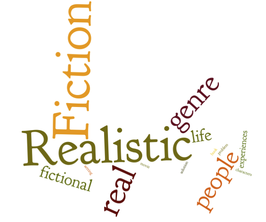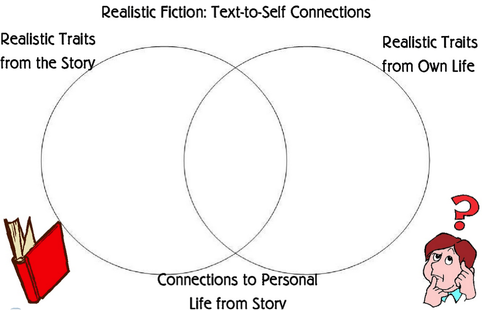
Definition
Realistic fiction has a strong sense of actuality. Its plausible stories are about people and events that could actually happen. Good contemporary realistic fiction illuminates life, presenting social and personal concerns in a fully human context.
Realistic fiction portrays the real world in all its dimensions; it shows the humorous, the sensitive, the thoughtful, the joyful, and the painful sides of life. By its very nature, it deals with the vast range of sensitive topics prevalent in today’s world. Lloyd Alexander (1981) reminds us that stories explore polarities, such as love and hate, birth and death, joy and sorrow, loss and recovery. Life’s raw materials, questions, and polarities appear most starkly in realistic fiction. Consequently, controversy often surrounds realistic fiction for children and adolescents.
Realistic fiction has a strong sense of actuality. Its plausible stories are about people and events that could actually happen. Good contemporary realistic fiction illuminates life, presenting social and personal concerns in a fully human context.
Realistic fiction portrays the real world in all its dimensions; it shows the humorous, the sensitive, the thoughtful, the joyful, and the painful sides of life. By its very nature, it deals with the vast range of sensitive topics prevalent in today’s world. Lloyd Alexander (1981) reminds us that stories explore polarities, such as love and hate, birth and death, joy and sorrow, loss and recovery. Life’s raw materials, questions, and polarities appear most starkly in realistic fiction. Consequently, controversy often surrounds realistic fiction for children and adolescents.
Common Misconceptions and Myths
No definition of realism is simple, and to say that realism is fiction that could happen in the real world—as opposed to fantasy, which could not—is simplistic. Every work of fiction, like the stories we tell ourselves, is part fanciful and part realistic. We selectively remember and reshape events of our past and present; the same thing happens in books. A realistic story is an author’s vision of what might really happen (the plot) in a particular time and place (the setting) to particular people (the characters).
Difficulties to Expect and How to Respond to Them
There are some novels, for instance Looking for Alaska by John Green, that parents and administrators might deem to have some scenes too inappropriate to be taught in the classroom.
1. Video of John Green defending his book.
The main problem that most people have with realistic fiction novels is the realism. It is a genre of young adult literature that does not shy away from addressing those issues that young adults actually face in real life. In fact, it tackles them head on. That is the appeal to both teachers and students alike. Realistic fiction addresses issues such as bullying in schools, family disputes, death, self-image, eating disorders, suicide, and rape, such hard-hitting issues that adolescents deal with every day. Rather than crucifying the authors trying to reach young adults on such a base level, the reading of their novels should be encouraged as a way for young adult readers to learn about the ways others dealing with the same issues get through them. These stories are largely inspiring, illustrating people who face up to adversity and overcome it.
2. Article on how to use realistic fiction in the classroom.
3. Article by Sherman Alexie, author of The Absolutely True Diary of a Part-Time Indian
Strengths
There are many values of contemporary realistic fiction. Young adults can:
No definition of realism is simple, and to say that realism is fiction that could happen in the real world—as opposed to fantasy, which could not—is simplistic. Every work of fiction, like the stories we tell ourselves, is part fanciful and part realistic. We selectively remember and reshape events of our past and present; the same thing happens in books. A realistic story is an author’s vision of what might really happen (the plot) in a particular time and place (the setting) to particular people (the characters).
Difficulties to Expect and How to Respond to Them
There are some novels, for instance Looking for Alaska by John Green, that parents and administrators might deem to have some scenes too inappropriate to be taught in the classroom.
1. Video of John Green defending his book.
The main problem that most people have with realistic fiction novels is the realism. It is a genre of young adult literature that does not shy away from addressing those issues that young adults actually face in real life. In fact, it tackles them head on. That is the appeal to both teachers and students alike. Realistic fiction addresses issues such as bullying in schools, family disputes, death, self-image, eating disorders, suicide, and rape, such hard-hitting issues that adolescents deal with every day. Rather than crucifying the authors trying to reach young adults on such a base level, the reading of their novels should be encouraged as a way for young adult readers to learn about the ways others dealing with the same issues get through them. These stories are largely inspiring, illustrating people who face up to adversity and overcome it.
2. Article on how to use realistic fiction in the classroom.
3. Article by Sherman Alexie, author of The Absolutely True Diary of a Part-Time Indian
Strengths
There are many values of contemporary realistic fiction. Young adults can:
- Identify with characters who have similar interests and who must deal with similar problems.
- Realize that, while their problems and challenges are difficult, they are shared by other adolescents.
- Extend their horizons and broaden their interests.
- Better cope with grief, fear, and anger as they read about other young adults or characters who have dealt with adversity.
Examples and Resources
Book Lists:
1. Realism Book List
2. Goodreads - Popular Realistic Fiction books for Middle Schoolers
3. Realistic Fiction for Teens
Realistic Fiction in the Classroom:
1. Reasons for Using and Teaching Contemporary Realistic Fiction
2. Using Realistic Fiction to Engage Middle School Students
3. Lesson Plan
What is Realistic Fiction:
1. A Quick Guide to Contemporary and Historical Realistic Fiction
2. Choosing High Quality Realistic Fiction
3. Contemporary Realistic Fiction

 RSS Feed
RSS Feed